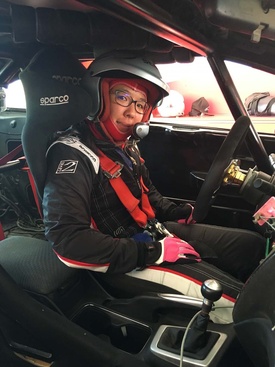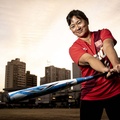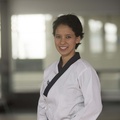Racing driver and support manager at Komatsu Mitsui in Lima, Carolina Shimabukuro Goto's life is a test of skill in mechanics, speed on the wheel and knowing how to avoid the prejudices that are put in front of her.
Since she was a child, she liked to play with cars with her brother or be in the workshop that her father had in the La Victoria district. “The mechanics made me take things apart or clean parts of the car, it was always full of grease.” She didn't want dolls (she hated Barbie), since she was a girl Carolina Shimabukuro Goto's dream was to be a car mechanic. When he was at La Unión school he already knew that he wanted to design his own racing car, which is why he did not hesitate to study at the Tecsup institute.
“In the fifth year of high school, I already knew that I wanted to study Heavy Machinery Maintenance. I found out everything to enter. At first, my parents wanted me to study engineering, but I was sure of what I wanted.” The fear of her parents, Tsutomu and Isabel, was that their daughter was in a world of pure men, where machismo dominates due to lack of opposition. But she was willing to break that pattern.
“In the entire room there were only three women. In the end, only I was left. To be respected I had to know more than the rest. In practical classes, I was the first to finish the assignments and when someone called me 'Chinese' once, I had to square it. Since then, they always treated me as an equal, they even told me things that are only said between men,” recalls Carolina, who managed to do an internship at Komatsu Mitsui, a company that would be closely linked to her professional future.
TEARING DOWN PREJUDICES
In his first steps he had to do everything to earn the trust of his bosses, all older men. Once she passed through the most basic stage of an intern, Carolina was sent throughout Peru to maintain heavy mining and construction machinery. There he faced more prejudice when they saw that it was a woman who arrived as a mechanic. His toolbox weighed fourteen kilos.
“I think many times it is thought that women can only stand out with a pretty face or smiling. But there are two ways: the other is with talent and effort," says Carolina, who comments that knowing about cars helped her to be in a man's world ("I don't know anything about soccer"), to be able to participate in their conversations and not be left alone. intimidate. “I feel comfortable, but at the beginning you always pay a flat fee.”
He spent three years at Komatsu Mitsui and then returned to stay for another eleven, moving through different areas until becoming support manager. “They supported me a lot, especially to continue my studies,” says Carolina. In 2008 he studied Administration at the Peruvian University of Applied Sciences - UPC and in 2013 he did an MBA at Centrum Católica thanks to a scholarship. But there is another career that Shimabukuro has followed in parallel and where he is always behind the wheel: that of a driver.
LOVE FOR IRONS
Carolina remembers that one day her brother Juan Carlos told her that he had signed her up for a race. It was 2002 and in the autocross competition (a skill race that takes place on a circuit with obstacles) women could register for free. “I liked it a lot, I made friends who lent me their best-prepared cars so I could compete.” Then came one of the experiences he always remembers: the South American rally in Huancayo, in the central mountains of Peru.
He was a co-driver in several tests in this modality that is done on dirt roads and in 2009, together with his brother, they decided to invest in racing together. “We got into debt, it was an odyssey to get there because we were driving the same car. Since it was rented, we were worried about crashing it in the competition so we went slowly and I think that helped us because we came fourth.” When she was a child, her entire family went to watch the races at the Santa Rosa circuit. Now, her dad always goes to see her compete.
A few years ago, he ventured into karts, participating in “La hora del kartismo 2012”, in Trujillo, where he came in second place. In 2017 he joined Team Yokohama of the TC Series by Honda, which competes in La Chutana, south of Lima. Together with four other girls, she has been demonstrating that knowing about cars is not a gender issue, and that the love for iron is also a woman's thing.
LIFE BEHIND THE WHEEL
When she goes from her home in Surco to her job in Callao, Carolina drives a compact Toyota or her beloved red Honda Civic Si with a Hello Kitty license plate. “Of course, it has to be a Japanese car, another one won't fit,” he says jokingly. Certain customs remained from his four Japanese grandparents, such as butsudan , where they keep photos of them, and Nikkei cuisine.
With the black Honda that she competes with, the same model that she has in red, Carolina had a mistake and flipped. Fortunately, she was unharmed (she was laughing before long), but she can't wait to drive again wearing her classic pink gloves. “Motor racing is a very expensive sport that needs a lot of support,” he comments, carrying his helmet with which he has reached more than 160 kilometers per hour.
On weekdays, he drives slowly because of traffic and because he knows that big changes take time. “When I started working at Komatsu Mitsui there were no dressing rooms for women. I had nowhere to change. "That's something we've been able to change," she says, also happy that more women are interested in mechanics, cars and racing, like her teammates from the Yokohama team or the friends who go to see her compete. Breaking patterns in society, breaking prejudices, is a race for everyone.
* This article is published thanks to the agreement between the Peruvian Japanese Association (APJ) and the Discover Nikkei Project. Article originally published in Kaikan magazine No. 111, and adapted for Discover Nikkei.
© 2017 Texto y fotos: Asociación Peruano Japonesa












